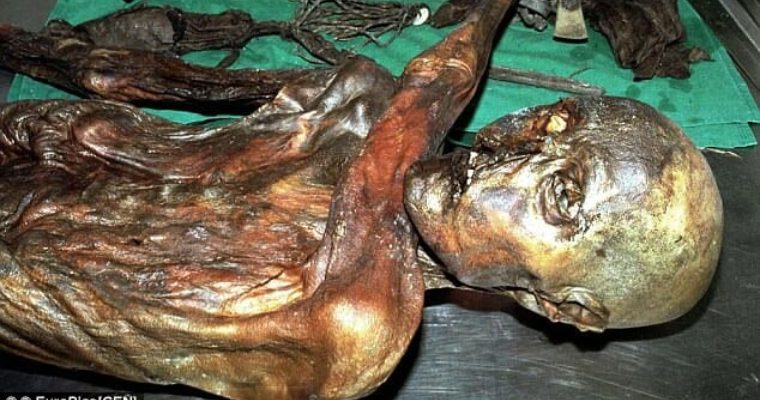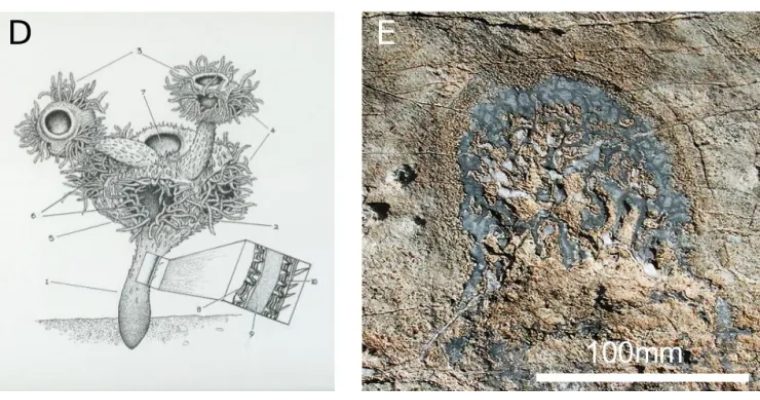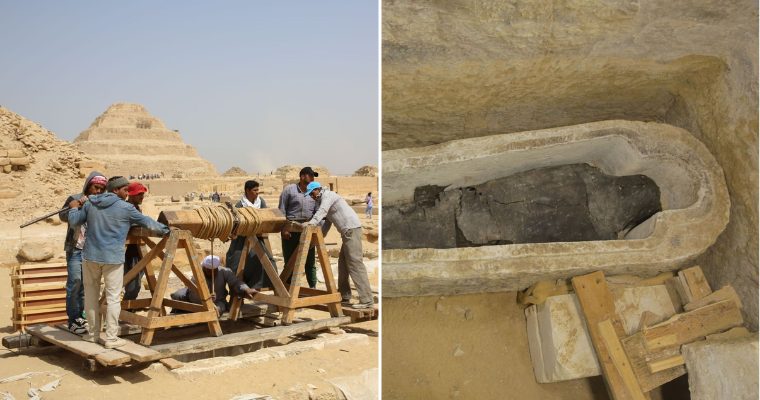A ‘black goo’ used by the ancient Egyptians to cover mummy cases was made from a mixture of animal fat, tree resin, beeswax and crude oil from the Dead Sea, scientists have revealed.
Several mummies were given this bizarre treatment from the 19th to 22nd Dynasty, between 1,300 and 750 BC.
One such by the name of Djedkhonsiu-ef-ankh, who was a priest to the sun-god Amun, was mummified, wrapped in fine linen and sewn into his case after he died almost 3,000 years ago.
Elaborate and brightly coloured painting was added to the material and shimmering gold leaf was placed over his face, before he was positioned inside a larger wooden coffin.
Jet-black gloop was then poured over him, obscuring the expensive paintwork and glint of gold forever.
Now analysis by the British Museum has revealed what the black substance is, and shed light on its purpose.

Priest of sun-god Amun, Djedkhonsiu-ef-ankh, had the ‘black goo’ applied to his coffin (pictured) after he died almost 3,000 years ago

It was used repeatedly in Egypt from 1,300 to 750 BC. It is thought to have been favoured due to its black colour – which is linked to regeneration. Coffin of Padihorpakhered, milk-bearer of Amun (left) and coffin of young girl Tjayasetimu

Pictured above is analysis of the ‘black goo’. Samples were broken up and then separated by mass to establish what was present
As many as 100 samples of the ‘black goo’ were taken and vaporised in a process called Gas Chromatography – Mass Spectrometry.
They were then pushed through a very thin and long tube to separate the molecules, and placed into a mass spectrometer so they could be sorted by mass.
‘We discovered that the goo is made of a combination of plant oil, animal fat, tree resin, beeswax and bitumen – which is solid crude oil,’ said Dr Kate Fulcher, Research assistant in the Museum’s department of Scientific research.
‘The exact ingredients vary from one coffin to the next, but the goo was always made from some of these.’
She also said it’s possible there could be other materials in the black substance, but these can no longer be detected as they have degraded.
The goo has also been found applied to just the face of mummies, boxes containing shabtis and wooden figurines such as a baboons.
Tutankhamun’s tomb also contained figurines covered in a hardened black liquid, although these have not been analysed.

It was also applied to statues such as this wooden baboon, which represents the judgement God Thoth. He was responsible for weighing the deceased person’s heart to establish whether they could enter the afterlife

A statue of a human with a head in the form of a turtle from the tomb of Ramesses I or Seti I. The black goo was made from pistachio tree resin in 19th dynasty Egypt

Scientists at the British Museum have analysed the substance poured over the coffin and established it is made from tree resin, animal fat, beeswax and crude oil
It is thought Egyptians used the fluid due to its black colour – which symbolised rebirth and regeneration through the God Osiris.
‘Osiris was called “the black one” in various funerary texts and is often depicted with black skin and in the guise of a mummified body,’ said Dr Fulcher.
‘Black is also the colour associated with the alluvial silt deposited on the banks of the River Nile after the annual flood receded.
‘It could therefore be reasoned that the practice of coating coffins in black goo links the coffin to regeneration associated with Osiris.’
The fluid also had the effect of fastening one coffin firmly inside another, although it is unclear whether this was meant to also help put off tomb robbers.
Evidence suggests that the substance may not have been available for everyone, and was instead restricted to the social elites.
Bucketfulls of the substance were found in Tutankhamun’s tomb, since cleaned off, and it is found most commonly on mummies from the Third Intermediate Period (1069 to 664 BC).
But Dr Fulcher suggested this may only be because Egyptoligists have recovered more coffins from this time period.
Excavations at Amara West, Sudan, have also revealed ‘black goo’ inside a tomb dated to 1100 BC. This is the first time it has been recorded in the region, then known as Nubia, which was under Egyptian control from 1548 to 1086 BC.
The bitumen used had also travelled from the Dead Sea, some 1,500 miles away, evidencing an ancient trade in the substance.

One of the two Guardian statues found in Tutankhamun’s tomb. It has been painted with a black fluid, although it is unclear whether this is the same ‘black goo’ used on ancient Egyptian tombs
It was found on broken pottery fragments, a coffin fragment and bits of linen that may have been used to wrap up a mummy.
Egypt sought to rule in the area due to its large gold deposits. The British Museum carried out the excavation with the support of the National Corporation for Antiques and Museums in Sudan. It was funded by the Qatar-Sudan Archaeological Project.
Scans of Djedkhonsiu-ef-ankh sealed coffin revealed the body was still inside and had not sustained significant damage.
There were no obvious fractures to the skull, and the mouth remains closed, said the British Museum.
His abdomen had been entirely filled with what appeared to be a mixture of sand, sawdust and resin during the mummification process, and his hands had been placed over the genital area.
The legs also showed no fractures, dislocations or lines of arrested growth.
A winged pectoral jewel, small amulet and scarab statue had also been placed onto the chest, while a ring with a scarab beetle has been identified between the thighs.
It is thought that the priest may have been in extreme pain before his death, as the spine shows gross osteo-arthritic changes.
source:ancient








